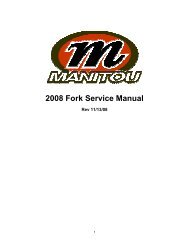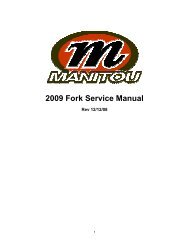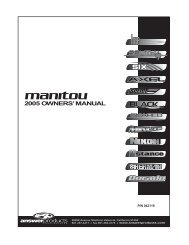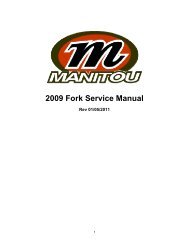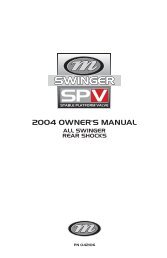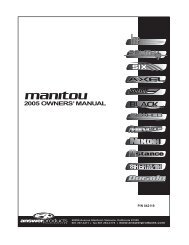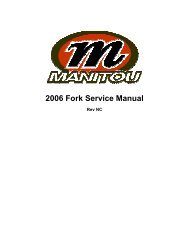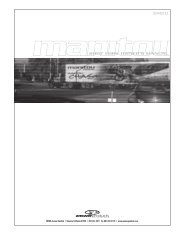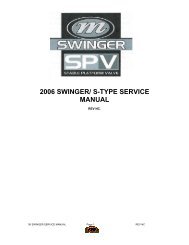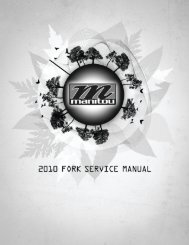2008 All Rear Shocks Owners Manual - Manitou
2008 All Rear Shocks Owners Manual - Manitou
2008 All Rear Shocks Owners Manual - Manitou
You also want an ePaper? Increase the reach of your titles
YUMPU automatically turns print PDFs into web optimized ePapers that Google loves.
MANITOU DAMPING SYSTEMS AND ADJUSTMENTS<br />
INTRINSIC DAMPING: REVOX, SWINGER and EVOLVER<br />
Designed to provide a high degree of bump sensitivity and wide range of<br />
adjustment, speed sensitive Intrinsic damping is a must-have for long travel<br />
suspension bikes. <strong>All</strong> Intrinsic shocks feature externally adjustable bottoming with<br />
the No Tools volume adjustment. Higher-end Intrinsic shocks feature high- and<br />
low-speed compression damping adjustments (located inside the piggyback<br />
reservoir) as well. SWINGER COIL X6, REVOX and EVOLVER ISX-6 have the added<br />
feature external adjustment of the high- and low-speed compression damping<br />
circuit. The red knob controls low-speed compression and the black knob controls<br />
high-speed compression.<br />
Low-Speed Compression Damping Adjustment – This adjustment<br />
controls low-velocity rear shock compressions and general ride firmness, and adds<br />
additional chassis-stability platform to the bike. Lighter (counterclockwise)<br />
adjustment provides a more supple/active ride but less chassis stability. Firmer<br />
(clockwise) adjustments provide a less supple/active ride but greater chassis<br />
stability platform.<br />
High-Speed Compression Damping Adjustment – This adjustment<br />
controls high velocity rear shock compressions and the response to sharp edge<br />
bumps and big hit conditions. The faster the rear shock is compressing, the more<br />
impact this adjuster has.<br />
NOTE: Over-turning the high- and low-speed pressure adjustment screws IN<br />
EITHER DIRECTION will damage the adjusters and valves. ONLY turn these adjuster<br />
screws until you feel resistance and then STOP.<br />
NO TOOLS VOLUME ADJUSTMENT: REVOX, SWINGER COIL and<br />
EVOLVER SHOCKS<br />
Air volume settings control the position sensitive compression damping feature of<br />
the rear shock. The No Tools volume adjuster is located on the end of the<br />
piggyback reservoir. The volume adjuster controls the rear shock’s bottoming<br />
resistance by varying the rise in compression force during the last 50% of the rear<br />
shock stroke. The No Tools volume adjuster has four numbered settings with<br />
different volumes. The #1 position has the largest volume, so this is the least<br />
progressive of all of the settings. The #4 position corresponds to the most<br />
progressive feel. When making air pressure adjustments on the reservoir, the<br />
volume adjuster should be set to the #1 position.<br />
TOOLED AIR VOLUME ADJUSTMENT: SWINGER AIR X4,<br />
SWINGER COIL X3<br />
This feature functions in a manner similar to the No Tools volume adjuster, but<br />
uses a 16 mm socket for adjustment. We recommend using the SPV Volume<br />
Adjustment Tool (part # 85-3007) to make this adjustment. Different from the No<br />
Tools volume adjuster, the air pressure should be reset any time a tooled volume<br />
adjustment is made.<br />
NO TOOLS SPV PLATFORM ADJUSTMENT: SWINGER AIR SHOCKS<br />
For <strong>2008</strong>, SWINGER AIR shocks feature an external adjustment for platform that<br />
does not require a pump or pressure adjustment. Located on the air canister end<br />
of the shock is a gun-metal gray knob that can be turned clockwise to increase<br />
platform. There are four distinct clicks that alter platform in approximately equal<br />
increments. SWINGER AIR shocks with external platform adjustment come fully<br />
charged at the factory, but an Authorized Dealer or Service Center can change the<br />
shock charge if higher or lower platform starting points are necessary.<br />
SPV DAMPING: EVOLVER SPV, SWINGER COIL SPV,<br />
and S-TYPE SPV REAR SHOCKS<br />
SPV damping creates an efficient platform to eliminate excessive movement<br />
(bobbing) from low resonance forces such as pedaling. To adjust platform, first set<br />
the pressure in the SPV chamber to roughly 75 psi (5 bar) BEFORE MAKING ANY<br />
SAG ADJUSTMENTS. Only after proper sag has been set should you then fine-tune<br />
your SPV pressure adjustment. Changing SPV pressure alters your platform<br />
threshold. Higher SPV pressures will provide a firmer platform for firmer pedaling,<br />
firmer ride control and a higher blow-off threshold. Likewise, decreasing pressure<br />
in the SPV chamber decreases platform.<br />
The SPV air pressure range for above shocks is 50-175 psi (3.5-12 bar). See<br />
“PRESSURE RANGES AND PRESSURIZING TIPS” for more information.<br />
NEVER USE A PRESSURE BELOW OR ABOVE THIS<br />
RECOMMENDED PRESSURE RANGE. SEE WARNING<br />
ABOVE.<br />
PLATFORM PLUS DAMPING: RADIUM R and METEL<br />
Designed to eliminate excessive movement while pedaling, this shim-based<br />
platform system is factory set on most models. Piggyback models like the METEL<br />
RPA feature an external Platform Plus adjuster located on the reservoir (small red<br />
adjuster). Turning the Platform Plus adjuster clockwise will increase platform<br />
threshold on the shocks. Turning the adjustment screw counterclockwise results in<br />
less platform. NOTE: Do not over-tighten or back out this screw beyond its<br />
stopping point. Doing so will damage the shock and void your warranty.<br />
LOCKOUT ADJUSTMENT<br />
The S-TYPE MRD, S-TYPE SRL, and RADIUM RL rear shocks feature a red lockout<br />
lever. Turning the lever counterclockwise will close the compression circuit to keep<br />
the rear shock from moving while climbing or riding on smooth surfaces.<br />
<strong>Manitou</strong>’s lockout system is a “soft lockout” meaning that even with the lockout<br />
on, the rear shock will compress when it encounters larger bump forces.<br />
For information and setup advice on remote lockout systems, please consult the<br />
“Service Guides” section of the HBsuspension.com website.<br />
REBOUND DAMPING ADJUSTMENT<br />
Rebound damping controls the return rate of the rear shock after it has been<br />
compressed to absorb a bump. Rebound on all <strong>Manitou</strong> rear shocks is adjusted<br />
with the blue knob. As a general rule, rebound that is adjusted for an overly fast<br />
rate will exhibit a springy ride that may cause excessive pedaling movement and<br />
kick up the rear end on multiple bumps and big hits. Rebound that is adjusted for<br />
an overly slow rate will exhibit a “packing” of the rear wheel that is identified by a<br />
low ride height, stiff feeling on multiple bumps and the rear wheel drifting to one<br />
side on stutter (braking) bumps. A good rebound starting point is to set the rear<br />
shock to achieve a return movement that is just short of “snapping back”.<br />
SPRING PRELOAD AND SAG ADJUSTMENTS:<br />
COIL REAR SHOCKS<br />
Spring preload adjustments are done with the spring preload adjustment ring.<br />
Adjust the spring preload adjuster up or down to achieve the desired amount of<br />
sag. Never exceed 8 mm/0.325" of preload on the coil spring. Always make sure<br />
that you have a minimum of 1 mm of preload on the spring. If you reach the<br />
maximum spring preload (8 mm) and the sag is too much, you’ll need to go to the<br />
next higher spring rate. If you reach the minimum amount of spring preload (1 mm)<br />
and there is not enough sag, you’ll need to go to the next lightest spring rate.<br />
Springs with varying, non-stock spring rates are available from HB Suspension for<br />
a fee. Part numbers, spring rates and travel are stamped on the outside of the<br />
spring coils. Coil spring part numbers are listed at the back of this manual.<br />
PRESSURE RANGES AND PRESSURIZING TIPS<br />
Maximum air shock main spring air pressure: 300 psi or 21 bar. Use <strong>Manitou</strong> air<br />
spring rear shock pump, part #85-4162, or similar rear shock pump that will<br />
deliver up to 300 psi (21 bar).<br />
Minimum-Maximum SPV pressure: 50-175 psi (3.5-12 bar) for all SPV shocks<br />
except SWINGER AIR X3 and SWINGER AIR X4. For the SWINGER AIR X3 and<br />
SWINGER AIR X4 pressures should be 100-175 psi (6.9-12 bar). Never use a<br />
pressure below or above this recommended pressure range. Use <strong>Manitou</strong> SPV<br />
pump, part #85-4163, or similar pump that will deliver up to 175 psi (12 bar).<br />
6



